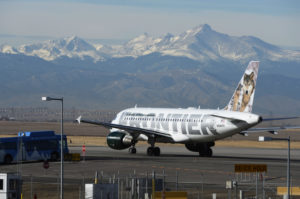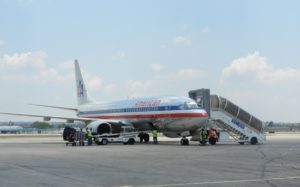If you have been waiting since last year for the first commercial flight between Philadelphia and Cuba, it’s not happening.
Frontier Airlines, which won permission for weekly trips between Philadelphia International Airport and Camaguey, Matanzas, and Santa Clara, Cuba, is pulling out of Cuba altogether.
Frontier will end its Miami to Havana route on June 4 because of overcapacity — too many flights — to the island nation, and higher-than-expected costs of operating at the Havana airport, said airline spokesman Jim Faulkner.
A new era of U.S.-Cuba travel was expected, with hundreds of scheduled flights a week ending a 55-year-old trade embargo on Cuba. The U.S. Department of Transportation in June approved six U.S. carriers to begin scheduled air service.
But “Lack of demand coupled with overcapacity by the larger airlines has made the Cuban routes unprofitable for all carriers,” said Misty Pinson, spokeswoman for Silver, which will suspend Cuba service on April 22.
American Airlines, with a hub in Philadelphia, is reducing frequencies to some destinations, and switching to smaller aircraft on a few routes.
American had 1,920 seats a day to Cuba until February, when it cut the number to 1,472. American will have 1,368 daily seats to Cuba next month.
“As markets develop we have to align our flights with what the market is showing us,” said Martha Pantin, American spokeswoman. “We need to remain competitive in the market, and that’s why we reduced service.”
American has four daily flights from Miami to Havana and one flight a day from Charlotte, N.C. to Havana.
Starting April 4, American’s regional partner, Republic Airways, will fly 76-seat planes instead of 128-seat aircraft between Miami and Camaguey and Cienfuegos, Cuba. “American is going to retain that route authority, but Republic will provide the service. We’ve been going with a bigger aircraft. Now we’re going with a regional flight,” Pantin said.
Frontier found the costs “to turn an aircraft” in Havana, such as landing, gate, and ground fees, were “significantly higher than we assumed,” said Faulkner, the spokesman.
“The market conditions failed to materialize,” he said. “There was just so much excess capacity allocated to the Florida-Cuba market.”
JetBlue is continuing to operate nearly 50 weekly round-trips to Cuba, but on smaller aircraft effective May 3, a spokesman said.
“I think airlines always saw Cuba as a long-term play, but I have to imagine it’s been worse than they expected to be pulling service to the degree they have,” said Seth Kaplan, managing partner of Airline Weekly, an industry publication.
“The simplest reason is that they can’t get enough people to fly there. As to why, it’s a combination of factors,” Kaplan said. “The tourism infrastructure in Cuba is spotty. Some people worry, ‘OK, if I go there, is it going to be the same kind of experience I’d have at another destination?’ And there’s still some ambiguity about ‘What if someone accuses me of being just a regular tourist and I’m not supposed to be there.’”
In addition, Americans cannot use U.S. bank-issued credit cards in Cuba. “You have to pay cash. Do you want to travel with $2,000 in your wallet?” Kaplan said. “So it’s a combination of some perception issues, and some realities like the inability to use a U.S.-issued credit card that make it a very different place from other destinations.”
FOLLOW US ON TWITTER AND FACEBOOK. THECUBANHISTORY.COM

SIGUEN LAS AEROLÍNEAS DE EEUU CORTANDO VUELOS A CUBA.
Si usted ha estado esperando desde el año pasado para el primer vuelo comercial entre Filadelfia y Cuba, no sucederá.
Frontier Airlines, que obtuvo permiso para los viajes semanales entre el Aeropuerto Internacional de Filadelfia y Camagüey, Matanzas, y Santa Clara, Cuba, está saliendo de Cuba por completo.
Frontier terminará su ruta entre Miami y La Habana el 4 de junio debido a la sobrecapacidad – demasiados vuelos – a la nación isleña, y costos más altos de lo esperado de operar en el aeropuerto de La Habana, dijo el portavoz de la aerolínea Jim Faulkner.
Se esperaba una nueva era de viaje entre Estados Unidos y Cuba, con cientos de vuelos regulares a la semana que terminaban con un embargo comercial de 55 años contra Cuba. El Departamento de Transporte de los Estados Unidos aprobó en junio seis transportistas estadounidenses para comenzar el servicio aéreo regular.
Pero “la falta de demanda junto con la sobrecapacidad de las aerolíneas más grandes ha hecho que las rutas cubanas no sean rentables para todos los transportistas”, dijo Misty Pinson, portavoz de Silver, que suspenderá el servicio de Cuba el 22 de abril.
American Airlines, con un centro en Filadelfia, está reduciendo frecuencias a algunos destinos, y cambiando a aviones más pequeños en algunas rutas.
American tenía 1.920 asientos al día a Cuba hasta febrero, cuando redujo el número a 1.472. American tendrá 1.368 plazas diarias a Cuba el próximo mes.
“A medida que los mercados se desarrollan, tenemos que alinear nuestros vuelos con lo que el mercado nos está mostrando”, dijo Martha Pantin, portavoz estadounidense. “Tenemos que seguir siendo competitivos en el mercado, y por eso hemos reducido el servicio”.
American tiene cuatro vuelos diarios desde Miami a La Habana y un vuelo al día desde Charlotte, N.C. a La Habana.
A partir del 4 de abril, el socio regional de American, Republic Airways, volará aviones de 76 asientos en lugar de aviones de 128 asientos entre Miami y Camagüey y Cienfuegos, Cuba. “Americano va a retener esa autoridad de la ruta, pero República proporcionará el servicio. Hemos estado yendo con un avión más grande. Ahora vamos con un vuelo regional “, dijo Pantin.
Frontier encontró que los costos “para convertir un avión” en La Habana, como el aterrizaje, la puerta y las tarifas de tierra, eran “significativamente más altos de lo que supusimos”, dijo Faulkner, el portavoz.
“Las condiciones del mercado no se materializaron”, dijo. “Había tanto exceso de capacidad asignada al mercado de la Florida-Cuba”.
JetBlue continúa operando cerca de 50 viajes de ida y vuelta semanales a Cuba, pero en aeronaves más pequeñas a partir del 3 de mayo, dijo un portavoz.
“Creo que las aerolíneas siempre vieron a Cuba como un juego a largo plazo, pero debo imaginar que ha sido peor de lo que esperaban que estuviera llevando el servicio al grado que tienen”, dijo Seth Kaplan, socio gerente de Airline Weekly, una publicación de la industria.
“La razón más simple es que no pueden conseguir suficiente gente para volar allí. En cuanto a por qué, es una combinación de factores “, dijo Kaplan. “La infraestructura turística en Cuba es irregular. Algunas personas se preocupan, ‘OK, si voy allí, va a ser el mismo tipo de experiencia que tendría en otro destino?’ Y todavía hay alguna ambigüedad sobre ‘¿Y si alguien me acusa de ser sólo un turista regular y No se supone que esté allí “.
Además, los estadounidenses no pueden usar tarjetas de crédito emitidas por los Estados Unidos en Cuba. “Tienes que pagar en efectivo. ¿Quieres viajar con $ 2,000 en tu billetera? “, Dijo Kaplan. “Así que es una combinación de algunos problemas de percepción, y algunas realidades como la imposibilidad de usar una tarjeta de crédito emitida en los Estados Unidos que la convierten en un lugar muy diferente de otros destinos”.
Agencias / PhillyNews / Linda Loyd / Excerpts/ Internet Photos/ Arnoldo Varona / TheCubanHistory.com
THE CUBAN HISTORY, HOLLYWOOD.








